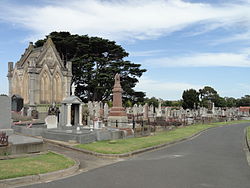Brighton General Cemetery
| Brighton General Cemetery | |
|---|---|
 Brighton General Cemetery | |
 | |
| Details | |
| Established | 1854 |
| Location | |
| Country | Australia |
| Coordinates | 37°54′0″S 145°1′15″E / 37.90000°S 145.02083°E |
| Website | Brighton General Cemetery (Southern Metropolitan Cemeteries Trust) |
| Find a Grave | Brighton General Cemetery |
Brighton General Cemetery is located in the Melbourne suburb of Caulfield South, Victoria, but takes its name from Brighton, Victoria.
History
The Cemetery pre-dates the Caulfield Roads Board - the first official recognition of the suburb of Caulfield. Established in 1854 it became, together with St Kilda Cemetery, an alternative resting place for those who had lived south of the Yarra River. There are up 70,000 people interred, including famous Australian artists, politicians and military heroes.
The first representative of the Jewish community of the Board of Trustees was Phillip Blashki. He organised the building of the Tahara house, where the deceased were watched until buried. He instigated the idea of half-graves for children, as they were expensive and child mortality was high in the 19th century. Blashki also founded the Jewish burial society, Chevra Kadisha, still in existence today.
War graves
The cemetery contains the war graves of 125 Commonwealth service personnel, 105 from World War I and 20 from World War II.[1] Most are members of the Australian Armed Forces, but three served for New Zealand Army (1) and British Army (2).
Notable Interments
Some of the notable people buried there include:
| Name |
Born |
Died |
Notes |
|---|---|---|---|
| Thomas Bent | 1838 | 1909 | 22nd Premier of Victoria[2] |
| Walter Bingle | 1861 | 1928 | Senior and career (federal) public servant[3] |
| Thomas Alexander Browne | 1826 | 1915 | British-born police magistrate and justice of the peace; later as novelist (Rolf Boldrewood) |
| Maurice Vincent Buckley | 1891 | 1921 | Soldier of the First Australian Imperial Force in Europe during World War I and recipient Victoria Cross (VC)[4] |
| Ada Cambridge | 1844 | 1936 | English-born fiction author, poet and autobiographer[5] |
| John Chanter | 1845 | 1931 | Politician (Australian MP, NSW MP and state cabinet minister) |
| George Henry Crowther | 1854 | 1918 | Founded Brighton Grammar School in 1882[6] |
| Jack De Garis | 1884 | 1926 | Market gardener, newspaper publisher, businessman and aviator[7] |
| Henry Deane | 1847 | 1924 | English-born civil engineer and railway pioneer |
| Elizabeth Eggleston | 1934 | 1976 | Australian activist, author, and lawyer[8] |
| Sheila Florance | 1916 | 1991 | Theatre, film and television actress |
| Adam Lindsay Gordon | 1833 | 1870 | Azores-born poet, jockey, police officer and politician (South Australian parliamentarian)[9] |
| Bernard Heinze | 1894 | 1982 | Music academic, conductor, Director of Sydney Conservatorium of Music[10] |
| George Higinbotham | 1826 | 1892 | Politician, Chief Justice |
| George Johnston | 1868 | 1949 | World War I General with First Australian Imperial Force[11] |
| Paul Jones | 1878 | 1972 | Goldminer, teacher, federal and state politician (Australian MP and Victorian Legislative Councillor)[12] |
| William Donovan Joynt | 1889 | 1986 | World War I Victoria Cross recipient (First Australian Imperial Force) and Australian Army officer during World War II;[13] later as publisher and author |
| Hugh Menzies | 1857 | 1925 | Victorian politician and brother of James Menzies and uncle of Sir Robert Menzies, former Prime Minister of Australia |
| John Monash | 1865 | 1931 | Civil engineer and World War I General with First Australian Imperial Force[14] |
| Charles Moore | ca.1858 | 1916 | Londonderry-born businessman and founder of Australian retail stores |
| James Newland | 1881 | 1949 | Soldier with First Australian Imperial Force and officer with the Australian Army, recipient of VC[15] |
| Walter Peeler | 1887 | 1968 | Soldier in the First Australian Imperial Force (WWI) and Second Australian Imperial Force (WW II), recipient of VC[16] and later as custodian of the Shrine of Remembrance |
| Henry Sutton | 1855 | 1912 | Inventor[17] |
| Eveline Winifred Syme | 1888 | 1961 | English-born landscape painter, print maker |
| Squizzy Taylor | 1888 | 1927 | Career criminal and gangster |
| Albert Thurgood | 1874 | 1927 | Australian rules footballer; later as bookmaker, cricketer and golfer[18] |
| Harry Trott | 1866 | 1917 | Postman and test cricketer |
| Howard Vernon | 1848 | 1921 | Operetta singer/actor[19] |
References
- ^ BRIGHTON GENERAL CEMETERY, VICTORIA CWGC Cemetery report. Breakdown obtained from casualty records.
- ^ Thomas Bent
- ^ Carr, Cecil, "Bingle, Walter David (1861–1928)", Australian Dictionary of Biography, Australian National University, archived from the original on 28 December 2014
- ^ Maurice Buckley
- ^ Ada Cambridge
- ^ George Crowther
- ^ Jack de Garis
- ^ Eggleston, Elizabeth Moulton
- ^ Adam Lindsay Gordon
- ^ Bernard Heinze
- ^ George Johnston
- ^ Paul Jones
- ^ William Donovan Joynt
- ^ John Monash
- ^ James Newland
- ^ Walter Peeler
- ^ Henry Sutton
- ^ Albert Thurgood
- ^ Howard Vernon
- The Jews in Victoria in the Nineteenth Century, L.M. Goldman 1954
- The enduring remnant:the first 150 years of the Melbourne Hebrew Congregation, 1841-1991,Joseph Aron, Judy Arndt, *Melbourne University Press, 1992 - History - 438 pages
- Phillip Blashki, A Victorian Patriarch, Gael R. Hammer, 1986 ISBN 0-9589451-0-1
